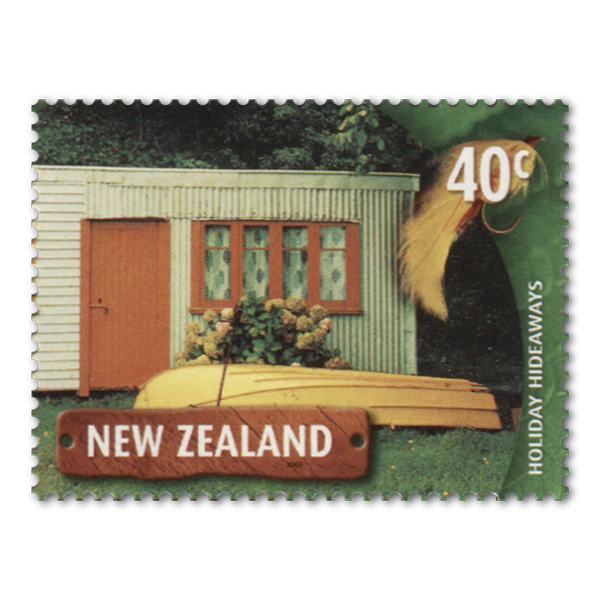Whether you call it a 'bach' or a 'crib', for New Zealanders the very word conjures emotions and images suffused with warm, affectionate nostalgia.
Issue information
In the North Island you would know them as 'baches', in the far South they're called 'cribs'. The epitome of the 'get away from it all' destination for generations of New Zealanders, these basic structures adorn our coastal landscape from north to south - to many they remain a treasured childhood memory, a vital piece of our cultural heritage and a natural part of our environment, and an expression of our personality.
Our six featured examples certainly captured the sense of pride and the many hours that must have been spent building and decorating them. Indeed, behind the love and energy of these modest dwellings is our desire to enjoy the summer in a place we can call our own. Somewhere for the family to lay their heads after a long day of sun, surf and mayhem!
Today, more afluent times have seen a sharp rise in the number of new holiday homes along our coastlines. And so it's sad to think that one day those earlier baches may fade away completely. This is why New Zealand Post decided to preserve such a cultural icon with this issue.
All in One Place
Corrugated iron, worn weatherboards and a tousled hydrangea shrub formed the perfect backdrop for the six stamps on the Holiday Hideaways first day cover.
Product Listing for Holiday Hideaways
| Image | Title | Description | Price |
|---|---|---|---|
 |
Single Stamp |
Single 40c 'Paua' gummed stamp. For a country so small, it's amazing that we have two names for our holiday homes. But that's the way it is - the 'bach' in the north, and the 'crib' in the far south. However, both share the same characteristics: they are refreshingly simple, humble abodes, a destination away from the stresses of everyday life in which to indulge in lazy contemplation. |
$0.40 |
 |
Single Stamp |
Single 40c 'Sunflower' gummed stamp. The traditional bach has the simplest of structures and is made of the most basic materials - fibrolite, corrugated iron or weatherboard - often painted in the kinds of colours you'd rarely see on New Zealand's suburban streets. Inside, they are havens of comfort that shun the trappings and timetables of sophisticated society. |
$0.40 |
 |
Single Stamp |
Single 40c 'Life Buoy' gummed stamp. The years between World Wars I and II heralded the heyday of bachbuilding, with another burst of activity in the 1950s and 60s. They were eras of kerosene lamps and woodburning stoves and outside the woodshed, washtub and 'long drop' toilet. Interior design was true 'Kiwiana' - Formica tables and chairs, lace curtains, patchwork rugs, candlewick bedspreads and lino for the floor. |
$0.40 |
 |
Single Stamp |
Single 40c 'Fish' gummed stamp. Days at the bach are never dull, and summer is always going to last forever. After a late start or a swim before breakfast, we go fishing, investigate rock pools for crabs or collecting driftwood, or just lie back with a good book while the scones bake for morning tea. Late afternoon barbecues, after dinner walks, singalongs with the guitar around a bonfire… such is life at the bach. |
$0.40 |
 |
Single Stamp |
Single 40c 'Fish Hook' gummed stamp. Bach life is undoubtedly a reflection of the Kiwi culture, where everyone pitches in to help - whether it's with the cooking or the odd coat of paint (to the minimum of course; at least to last until next summer). It's a community existence, where people treat each other as family more than friends and no one is judged by their bach or their possessions. |
$0.40 |
 |
Single Stamp |
Single 40c 'Caravan' gummed stamp. The bach has become a Kiwi icon, up there with jandals, pavlova and Buzzy Bees. Unfortunately though, it may be under threat, as coastal properties become increasingly popular and therefore valuable and highly sought after. Many bachs are giving way to far more luxurious dwellings that are much less 'holiday' and much more 'home'. |
$0.40 |
 |
First Day Cover | First day cover with stamps affixed. Cancelled on the first day of issue. | $2.90 |
Technical information
| Date of issue: | 6 November 2002 |
|---|---|
| Number of stamps: | Six |
| Denominations and designs: | 40c Paua, 40c Sunflower, 40c Life Buoy, 40c Fish, 40c Fish Hook, 40c Caravan |
| Stamps and first day cover designed by: | Cato Partners, Wellington, New Zealand |
| Printer and process: | Southern Colour Print, Dunedin by offset lithography |
| Number of colours: | Four process colours |
| Stamp size and format: | 40mm x 30mm (horizontal) |
| Paper type: | De la Rue 103gsm red phosphor stamp paper |
| Perforation gauge: | 14 |
| Number of stamps per sheet: | 25 |
| Special blocks: | Plate/imprint blocks could be obtained by purchasing at least six stamps from a sheet. Barcode, value blocks and logo blocks could be obtained by purchasing at least two stamps from a sheet. Barcode blocks were available in both A and B formats. |
| Period of sale: | These stamps remained on sale until 5 November 2003. |

